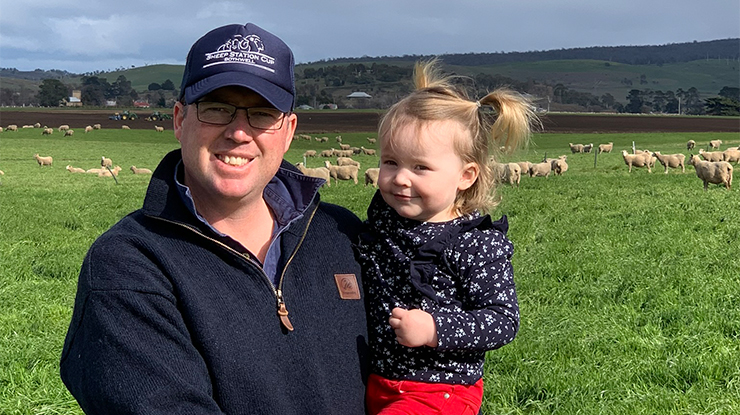 John Ramsay with daughter Matilda.
John Ramsay with daughter Matilda.
In MLA's 'Down the track' series, we catch up with producers who have been profiled in the past to see how their business is evolving in response to new challenges and opportunities.
Looking back
In 2014, Tasmanian sheep producers John and Annie Ramsay won the inaugural MLA Challenge after transforming their business in just 12 months using MLA tools and resources. Their focus on people and rigour in decision‑making, as a result of the challenge, has taken their business from strength to strength.
Looking ahead
Six years ago, Tasmanian sheep producers John and Annie Ramsay were selected for the inaugural MLA Challenge – what they didn't realise was they were embarking on a journey that would reshape their business.
Through the MLA Challenge, a group of six beef and sheep producers set out to improve efficiencies and productivity within their farming operations over 12 months, using the best tools, resources and advice available.
At the time, John and Annie wanted to move into a livestock and cropping system but were unsure how to go about it. They thought the Challenge sounded like a good way to be helped through the process.
Prior to the Challenge, the Ramsays were running about 5,000 ewes. They had 500ha of cropping – poppies and cereals – and were finishing around 1,000 to 2,000 Merino‑cross lambs.
Since then, they've increased their turn‑off of crossbred lambs to 10,000.
Here's a look at how they did it.
Under the microscope
As part of the Challenge, MLA provided producers with a mentor, farm consultant, tools and resources.
Participants – who came from a range of enterprises – were assessed quarterly against various key performance indicators.
These differed for each producer, but for John and Annie included:
- setting the correct stocking rate
- putting the rams out on time
- lamb marking percentage.
MLA looked at how well the producers were using the resources and assessed the extent to which they conducted research, drew on their mentors and used MLA's online tools.
They were also judged on how well they conveyed their story, via a quarterly blog and social media.
The Ramsays' mentor and consultant helped them recognise that Merinos weren't the best fit for their wet, exposed irrigation country.
During the MLA Challenge year, in addition to moving away from cropping, they sold their Merinos and moved into composite ewes.
Part of the prize was 12 months' advice from MLA Challenge judge Sam Newsome of Newsome Agriculture at Tamworth, and the Ramsays have retained him as their advisor.
Rigour around decisions
The lessons the Ramsays took from the 12‑month Challenge continue to benefit their business today.
The biggest shift has been the rigour John and Annie now apply to their decision‑making.
"We'd decide how many ewes we ran on a particular paddock by what 'felt right," John said.
"If I'd used MLA resources and put some rigour around the decisions back then, I would have made better decisions and more money."
People power
The Challenge also taught John to focus on the people side of the business.
"I went into the Challenge with a pure production emphasis, but hats off to Sam. He showed me that you need the right team on the ground to get results. That was a real eye opener for us.
"Now when I think 'team', I think about our farm team, but I also think beyond that. It's your agronomist, your accountants, your consultants, your wife or your business partners or the whole HR set‑up. It's the people that make it work."
Goal setting
John and Annie now set goals around measures such as return on assets, soil health, labour efficiency and lambing percentages.
"Our top goal is a return on assets (ROA) managed of more than 5%," John said.
Other KPIs are:
- lambing percentages above 140%
- lamb growth rates above 200g/day
- stocking rate of about eight ewes/ha
- poppy yields grossing $4,000/ha
- labour efficiency of one labour unit/7,500 DSE (dry sheep equivalent).
They're hitting their goals more often than not, apart from the 5% ROA, but John reckons they're a bit hard on themselves with this measure as they record some labour and expenses as direct costs, when they are actually capital costs.
Networks
Following the Challenge, John founded the Fat Ewe Group, a group of seven producers who are graduates of the Lifetime Ewe Management course.
The group, who all operate composite ewes and irrigation systems, meet seven times a year with one visit to each farm.
"It's been terrific. There are no silver bullets, unfortunately, but it's been educational on many fronts. It's great to learn through that process."
Tools and resources
John was introduced to MLA's stocking rate calculator during the Challenge and has continued to use it for lambing and to determine how many ewes to run per hectare.
He also uses an Excel‑based feed budgeting tool, based on soil and pasture growth rates and livestock consumption information from MLA.
In addition to his producer group and industry publications, John sources information from MLA's website, MLA's Facebook and Friday Feedback.
Since completing the Challenge, the Ramsays bought land they were leasing at Bridport, Tasmania.
They've also put on two more irrigators at Bothwell and bought some more water.
John said he has realised the value of 'pushing the envelope'.
"During the Challenge, we really pushed our stocking rate. I thought, 'I don't know if we can do this', but we had all the people and tools and help saying, 'yes you can'. And it worked.
"Now, we're always looking to grow the business. That's one of our goals. The Challenge has taught me to look at every opportunity that arises."
|






